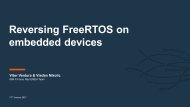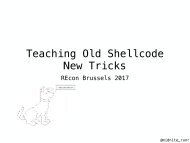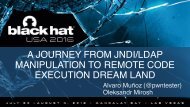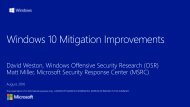ANALYSIS OF THE ATTACK SURFACE OF WINDOWS 10 VIRTUALIZATION-BASED SECURITY
us-16-Wojtczuk-Analysis-Of-The-Attack-Surface-Of-Windows-10-Virtualization-Based-Security
us-16-Wojtczuk-Analysis-Of-The-Attack-Surface-Of-Windows-10-Virtualization-Based-Security
Create successful ePaper yourself
Turn your PDF publications into a flip-book with our unique Google optimized e-Paper software.
Rafal Wojtczuk<br />
rafal@bromium.com<br />
<strong>ANALYSIS</strong> <strong>OF</strong> <strong>THE</strong> <strong>ATTACK</strong> <strong>SURFACE</strong> <strong>OF</strong><br />
<strong>WINDOWS</strong> <strong>10</strong> <strong>VIRTUALIZATION</strong>-<strong>BASED</strong><br />
<strong>SECURITY</strong>
aAgendaupa<br />
• Short reminder on VBS architecture<br />
• Credential Guard properties and internals<br />
• HV Code Integrity properties and internals<br />
• Hyper-V security/complexity/attack surface<br />
• More details in the whitepaper
aScopeupa<br />
• Most of this research done with W<strong>10</strong> 1511<br />
• Intel’s hardware (when hw mentioned)<br />
• Mixed original, little-known and well-known<br />
content
VBS architecture
aCredential Guard architectureupa<br />
Picture taken from BH2015<br />
Microsoft presentation
Mimikatz fails on CG-protected box
aCG scenario 1upa<br />
• Admins just enabled CG in Group Policy<br />
• No further hardening<br />
• Easy to deploy
aCG RPC interfaceupa<br />
LsaIso trustlet, running in VTL1, exposes the above functions via RPC over ALPC port \RPC Control\LSA_ISO_RPC_SERVER
aNtlmIumProtectCredentialupa<br />
• Input (from lsass.exe): plaintext credentials<br />
• Output (from LsaIso.exe) : blob with encrypted<br />
credentials
aNtlmIumLm20GetNtlm3Challen<br />
geResponseupa<br />
• Input (from lsass.exe): blob with encrypted<br />
credentials + NTLM challenge<br />
• Output (from LsaIso.exe): NTLM response
aScenario 1 propertiesupa<br />
• After logon, no cleartext credentials in lsass<br />
• While user is logged in, lsass will auth to remote<br />
servers automatically (SSO), for attacker as well<br />
• If attacker collects encrypted blob, he can force<br />
LsaIso to auth even after logout (until reboot)<br />
• Demo
Credentials during logon ?<br />
• There is still a problem with how the unencrypted<br />
credentials are initially delivered to VTL1 (which happens<br />
during logon).“rundll32.exe user32.dll,LockWorkStation”.<br />
• If not using smart-card based authentication, then the<br />
plaintext credentials can be captured by keylogger and<br />
used anywhere, anytime.<br />
• In case of smart-card based authentication, the NTOWF<br />
hashes sent by KDC can be captured and reused.
aCG scenario 2upa<br />
• Credential Guard with armor key protection and<br />
smartcard-based authentication<br />
• Nontrivial deployment challenge<br />
• Possible to enable without TPM, but in such<br />
case no real advantage
aCG scenario 2upa<br />
Picture taken from BH2015<br />
Microsoft presentation
aScenario 2 properties<br />
• No more cleartext creds in lsass, ever<br />
• Still, as before, until reboot, attacker can<br />
interact with CG and have it perform all SSOsupported<br />
authentications for remote resources<br />
• There is no reliable way to deliver “user has<br />
logged out, refuse future SSO” message to VTL1
aCG properties summary<br />
• Even in the most hardened configuration, once attacker has<br />
SYSTEM privileges, they can silently authenticate as logged-in<br />
user to remote servers, from the compromised machine, until<br />
reboot<br />
• No more classical pass-the-hash – but attackers can adapt and<br />
start lateral movement from the same machine, until reboot<br />
• In classical pass-the-hash, one can reuse stolen hashes<br />
anytime, from anywhere – thus CG is an improvement<br />
• Again, no hypervisor compromise required for the above<br />
attack, just root partition compromise
VBS-enforced code integrity<br />
• Windows <strong>10</strong> can enforce code integrity of<br />
usermode binaries, usermode scripts and<br />
kernelmode code; the latter via VBS<br />
• We focus on kernelmode case<br />
• The goal – not allow execution of any unsigned<br />
code in kernel context, even if the kernel has<br />
been compromised
VBS-enforced code integrity<br />
• Basic idea: trusted code (running in VTL1)<br />
agrees to grant execute rights in EPT tables of<br />
the root partition only for pages storing signed<br />
code<br />
• No such page can be both writable and<br />
executable
Mixing signed & unsigned code<br />
• Common configuration: unsigned usermode code<br />
allowed, unsigned kernelmode denied<br />
• Usermode wants to execute unsigned code at C<br />
– VTL1 must grant execute right for C in EPT<br />
• Usermode switches to kernelmode, and jumps to C<br />
– ?
Kernel HVCI is based on secvisor<br />
• Separate EPT for code originating from signed<br />
and unsigned page<br />
• Root partition is configured so that any attempt<br />
by unsigned usermode code to enter<br />
kernelmode results in vmexit (and EPT flip)<br />
–IDT, GDT limits set to 0, syscall&sysenter disabled
Kernel HVCI and kernel exploits<br />
• Attackers love arbitrary code running in ring0<br />
• SMEP a problem, but natural bypass:<br />
– Get ROP capability, then clear CR4.SMEP<br />
– Or, via write-what-where, clear U/S bit in PT<br />
– Run your arbitrary code<br />
• Not working with Kernel HVCI !<br />
• Also, cannot hook kernel code, at least not directly<br />
• Data-only exploits, or ROP-only, still fine
Kernel HVCI bypass, MS16-066<br />
• Before MS16-066 fix, there are some pages with<br />
RWX permission in root partition (kernelmode)<br />
EPT<br />
• Likely artifacts of early boot phase<br />
• Attacker can find them by probing each physical<br />
page for write and execute, in ring0
Kernel HVCI bypass, MS16-066
HYPERV-V <strong>SECURITY</strong>
[Un]usual threat model<br />
• Usual model: hypervisor must be resistant to attacks<br />
coming from unprivileged, worker VMs<br />
• Without VBS, root partition is semi-trusted; it can<br />
compromise Hyper-V (no big deal) because<br />
– HvCallDisableHypervisor hypercall<br />
– Cleartext hiberfile<br />
– VTd not enabled<br />
• With VBS, the threat comes from the root partition
Necessary support<br />
• Secureboot<br />
– many vulnerabilities in the past allowing secureboot<br />
bypass<br />
• VTd<br />
– without it, possible to overwrite hypervisor via DMA<br />
• TPM<br />
– needed to secure S4, see below
Root partition privileges<br />
• Access to privileged hypercalls<br />
–Hypervisor Top-Level Functional Specification<br />
mentions 14 hypercalls usable by nonprivileged<br />
VM, and 67 privileged hypercalls. More hypercalls<br />
exist, entirely undocumented.<br />
• Possible to overlook some dangerous<br />
functionality, or e.g. memory corruption bug
Root partition privileges<br />
• Access to almost all physical memory range<br />
–Without pages allocated for Hyper-V and VTL1<br />
–Including<br />
• chipset and PCIe MMIO<br />
• ACPI NVS<br />
–LAPIC and VTd bars not accessible
Root partition privileges<br />
• I/O ports: all available except:<br />
• 32, 33 (PCH interrupt controller), 160, 161 (same)<br />
• 0x64, lpc microcontroller (A20 gate)<br />
• 0xcf8, 0xcfc-0xcff – PCI config space<br />
• 0x1804. It is PMBASE+4 == PM1_CNT, it holds the<br />
SLP_EN bit, that triggers S3 sleep; see below
Root partition privileges<br />
• MSR – none available directly except :<br />
• three SYSENTER MSRS<br />
• fs/gs/shadow gs base<br />
• So, Hyper-V has at least a chance to react<br />
properly
Problem 1 – unfiltered MMCFG<br />
• MMCFG is a region of physical address space; access<br />
to it results in PCIe config space access<br />
– Device-specific registers, memory bars locations<br />
• REMAP_LIMIT/REMAP_BASE are locked<br />
• Overlapping RAM with PCIe memory bar does not<br />
work<br />
• Anything else interesting we can overlap/cover ?
But write access hangs the tested platform <br />
Overlap VTd bars
Problem 2 – chipset registers<br />
• Some memory-mapped regions, e.g. in<br />
MCHBAR, have thousands of registers, most of<br />
them undocumented at all<br />
• Are all of them locked ? Anything evil can be<br />
done ?<br />
• I do not know
S3 sleep<br />
• S3 is fragile from security POV<br />
• Boot script hijack vulnerability from 2014 could<br />
be used to take control over the hypervisor<br />
– likely all firmware makes were affected<br />
• More potential attacks via S3 thinkable (see the<br />
whitepaper)
S4 sleep<br />
• S4 is even more fragile from security POV<br />
• Need to protect integrity of hiberfile<br />
• With VBS, it is encrypted<br />
• Need to keep the key secret<br />
• If TPM available, the key is sealed to TPM<br />
• If no TPM, then the key is cleartext in UEFI variable
S4 is insecure without TPM
SMM<br />
• SMM is highly-privileged mode of CPU,<br />
unrestricted by hypervisor<br />
• Usually, firmware vendors pack quite some<br />
services in SMM; they can be invoked by write<br />
to I/O port 0xb2<br />
• A lot of bugs in SMM found recently
SMM code tends to be buggy
SMM<br />
• It is well-known that SMM vulnerability can be<br />
used to compromise a hypervisor in runtime<br />
– BTW, secureboot as well<br />
• VBS allows direct access to I/O port 0xb2, as<br />
well as to ACPI NVS<br />
• Intel researchers demoed searching VTL1<br />
memory for password hashes
SMM abuse example
SMM abuse example
SMM
Summary<br />
• Despite its limited scope, VBS is useful<br />
• A lot of effort by MS to make it as secure as<br />
possible; still, unusual attack surface<br />
• VTd, TPM strictly necessary (with secureboot)<br />
• SMM vulnerabilities the greatest threat
Questions ?
Extra slides: Non-VBS-specific<br />
• CPU erratas<br />
threats<br />
• Rowhammer<br />
• Flashable discrete hardware
VTL1 attack surface<br />
• RPC services implemented in LsaIso (including RPC<br />
demarshalling code)<br />
• 48 services implemented in<br />
securekernel!IumInvokeSecureService (called by nt!<br />
HvlpEnterIumSecureMode)<br />
• VTL1 extensively calls into VTL0 to use some<br />
services – need to sanitize all responses
Other funny chipset capabilities<br />
• E.g. chipset can program DRAM SPD<br />
• Capability locked by sane BIOS<br />
Picture taken from<br />
Wikipedia article<br />
on Serial Presence<br />
Detect









